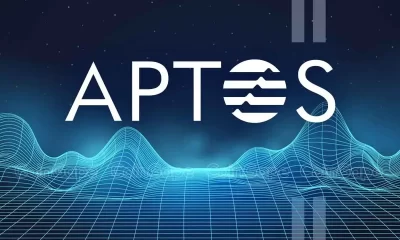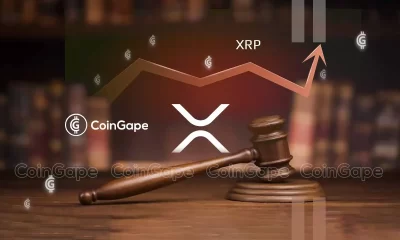Uncategorized
Nigeria’s new crypto tax policies may not drive the revenue it needs
Published
3 weeks agoon
By
admin
In February, Nigeria sued Binance for unpaid taxes and introduced new cryptocurrency taxations in an effort to boost its faltering economy, but it may not have the intended effects.
As the 53rd largest economy in the world, Nigeria is predicted to enjoy the highest average GDP growth between 2010 and 2050, according to Citigroup. However, the country’s economic development has faltered in recent years, forcing the government to introduce significant tax reforms, a minimum wage framework, and more.
The country claims pursuing unregulated crypto exchanges like Binance can provide more than $81 billion to refill its coffers, aided by introducing a tax on cryptocurrency transactions.
Still, according to Nic Puckrin, founder of The Coin Bureau, this tax won’t be a clear-cut solution: “Nigeria has one of the largest markets for retail OTC trading. Moreover, importers have often resorted to crypto to deal with volatile NGN exchange rates. … they are going to have a very hard time collecting that.”
Nigeria’s expected gross domestic product (GDP) until 2029. Source: Statista.
Nigeria’s corruption hinders crypto taxation
Nigeria is home to Africa’s largest cryptocurrency market. A reported 22% of its population (about 47 million people) owns or uses crypto assets. Since the country reversed its ban on digital currencies in 2021, the Nigerian government has not been slow in responding to the growth and adoption of cryptocurrencies.
Nigeria’s Securities and Exchange Commission (SEC) issued its Rules on Digital Assets in 2022, recognizing crypto as securities and providing guidelines for exchanges and custodians.
The government seems serious about getting key gains from crypto transactions and recently instituted proceedings against Binance, seeking to compel the exchange to pay $81.5 billion for economic losses it claims were caused by the exchange’s operations in the country and $2 billion in back taxes.
The government’s 2023 National Blockchain Policy (2023) seeks to integrate blockchain into public services, signaling long-term crypto alignment. The CBN’s eNaira, Africa’s first CBDC, and fintech startups like Flutterwave and Chipper Cash have expanded financial inclusion within the country, reaching 64% of adults in 2023.
Maksym Sakharov, co-founder and board member of WeFi, outlined:
“Nigerian regulators understand the country’s place within the global cryptocurrency industry. Besides being the largest economy in Africa, it also has the highest crypto adoption level, making the prospect of taxing crypto transactions an economically promising move.”
Sakharov continued, “However, the country is known for its poor implementation of market-changing policies like this.” While Nigeria seems keen to move forward with taxation on transactions, it often fails when it comes to implementation, owing to high levels of corruption.
Nigerians primarily use peer-to-peer (P2P) trading platforms to counteract the effects of the country’s currency depreciation and high inflation. This level of crypto adoption, however, hasn’t produced significant GDP growth — but it has supported Nigeria’s digital economy, which contributed 18.4% to GDP in Q4 2023.
Nigeria, expected inflation rate to 2029. Source: Statista.
A tax on all your crypto
According to the World Bank, Nigeria’s tax-to-GDP ratio is one of the lowest globally at 6%. Nigeria’s Federal Inland Revenue Service (FIRS) reported collecting 10.1 trillion Nigerian naira ($12.7 billion) in 2022, with only 12% of the labor force formally employed and contributing taxes. VAT and corporate taxes dominate revenue, while personal income tax compliance is weak.
With only 9% of Nigeria’s 70 million taxable adults paying income taxes in 2022, this move to tax individual cryptocurrency transactions may have an ulterior motive — collecting taxes from the informal sector and unbanked population. The informal sector in Nigeria makes up 65% of the country’s GDP, and currently operates primarily outside of the government’s tax net.
Maksym continues: “While taxing crypto is not out of place, most crypto traders in the country have lost faith in the government and might find a way to bypass these taxation provisions. With the biggest exchange, Binance, not fully operational in the country, users have developed a thriving P2P and OTC desk to conduct their transactions.”
Related: Nigerian SEC tightens crypto marketing rules
With 45% of Nigerian adults unbanked but 35% using crypto for remittances and savings, taxing crypto transactions is a clear move toward tapping into the informal economy. The proposed 0.5–1% capital gains tax on crypto profits and 10% VAT on exchanges could generate up to 200 billion Nigerian naira ($250 million) annually.
However, the risk of over-taxing cryptocurrency users could push them toward using unregulated P2P platforms, undermining compliance.
Nic Puckrin, founder of The Coin Bureau, says the government will struggle to collect taxes.
“Nigeria has a thriving P2P ecosystem, so if users wanted to evade having to pay the fees on centralized exchanges, they would just take it off the platforms. I also don’t think the government has the resources to enforce this or track down those who don’t want to play ball.”
Nigeria’s crypto tax proposal does reflect a broader push to formalize the digital and informal economies while addressing fiscal pressures. Success hinges on balancing regulation with innovation — while ensuring compliance.
Excessive taxation would stifle adoption, but prudent, well-implemented policies may expand the country’s revenue and enable further financial inclusion.
Nigeria could strengthen enforcement by adopting blockchain analytics tools. India collaborated with Chainalysis to integrate these as tools for tracing taxable transactions. The country’s recent SEC guidelines for virtual asset service providers (VASPs) already align with FATF recommendations, enabling better oversight of formal exchanges.
Anti-corruption initiatives like digitizing tax processes and expanding the Economic and Financial Crimes Commission’s (EFCC) mandate could reduce leakages. The EFFC’s mandate states that it seeks to support Nigeria’s mission to become a country free of economic and financial crimes. By combining tech-driven transparency measures with public education on tax benefits, Nigeria may gradually build trust and compliance in its crypto economy.
Magazine: Mystery celeb memecoin scam factory, HK firm dumps Bitcoin: Asia Express
Crypto Whale’s Losses on TRUMP Memecoin Balloon to $15,700,000 After Exiting Three Losing Trades in a Row FDIC Says Banks Can Engage In Bitcoin And Crypto Without Prior Approval FDIC Clears Path for Bank Crypto Activities Without Prior Approval Seasoned traders reveal leading crypto for 2025 and it’s not XRP or Solana Here’s Why Peter Schiff Predicts Bitcoin (BTC) Price Crash to $10K Chainlink Monthly Close To Determine LINK’s Fate, $19 Next? Published on By Billionaire investor Elon Musk has sold his social media platform X to his AI startup xAI, sparking controversy as it coincides with a US judge rejecting his bid to dismiss a lawsuit tied to the social media platform. The transfer of ownership of X to xAI on March 28 means that the class-action lawsuit against Musk — accusing him of defrauding former Twitter shareholders by delaying the disclosure of his initial investment in the social media platform — has become “a whole lot spicer,” Cinneamhain Ventures partner Adam Cochran said in a March 28 X post. On the same day that Musk said “xAI has acquired X in an all-stock transaction,” a US judge reportedly rejected Musk’s attempt to dismiss the lawsuit. Cochran said it has “opened up his AI entity to exposure here too, and it’s a much bigger pie.” Source: Grok Musk said the deal values xAI at $80 billion and X at $33 billion, factoring in $12 billion in debt from the $45 billion valuation. He originally bought X, formerly Twitter, for around $44 billion in April 2022. “xAI and X’s futures are intertwined. Today, we officially take the step to combine the data, models, compute, distribution and talent,” Musk said. Source: Bryan Rosenblatt “This combination will unlock immense potential by blending xAI’s advanced AI capability and expertise with X’s massive reach,” he said, adding: “This will allow us to build a platform that doesn’t just reflect the world but actively accelerates human progress.” However, Cochran claimed that “Musk used his pumped up xAI stock to pay multiple times over value for X, but still take an $11B loss on the transaction.” He said that Musk is “screwing over xAI investors, and X investors” and was executed to sell user data to xAI. Related: Elon Musk’s ‘government efficiency’ team turns its sights to SEC — Report xAI is best known for its AI chatbot “Grok” which is built into the X platform. When Musk released it in November 2023, he claimed it could outperform OpenAI’s first iteration of ChatGPT in several academic tests. Source: Raoul Pal Musk explained at the time that the motivation behind building Grok was to create AI tools equipped to assist humanity by empowering research and innovation. While Cochran said that Grok’s valuation at $80 billion is an “insanely dumb valuation,” crypto developer “Keef” disagrees. Keef said, “This is shady all around, but given the day, Grok is genuinely probably the top model for various tasks.” Magazine: Arbitrum co-founder skeptical of move to based and native rollups: Steven Goldfeder Published on By The Federal Deposit Insurance Corporation (FDIC) said in a March 28 letter that institutions under its oversight, including banks, can now engage in crypto-related activities without prior approval. The announcement comes as the Commodity Futures Trading Commission (CFTC) announced that digital asset derivatives wouldn’t be treated differently than any other derivatives. The FDIC letter rescinds a previous instruction under former US President Joe Biden’s administration that required institutions to notify the agency before engaging in crypto-related activities. According to the FDIC’s definition: ”Crypto-related activities include, but are not limited to, acting as crypto-asset custodians; maintaining stablecoin reserves; issuing crypto and other digital assets; acting as market makers or exchange or redemption agents; participating in blockchain- and distributed ledger-based settlement or payment systems, including performing node functions; as well as related activities such as finder activities and lending.” FDIC-supervised institutions should consider associated risks when engaging in crypto-related activities, it said. These risks include market and liquidity risks, operational and cybersecurity risks, consumer protection requirements, and Anti-Money Laundering requirements. On March 25, the FDIC eliminated the “reputational risk” category from bank exams, opening a path for banks to work with digital assets. Reputational risk is a term that underscores the dangers banks face when engaging with certain industries. Related: FDIC resists transparency on Operation Chokepoint 2.0 — Coinbase CLO While the US crypto derivatives market had been a gray zone due to regulatory uncertainty, that has been changing. On March 28, the CFTC withdrew a staff advisory letter to ensure that digital asset derivatives — a type of trading product — will not be treated differently from other types of derivatives. The revision is “effective immediately.” The change in tone from the CFTC and FDIC follows a new environment for crypto firms under US President Donald Trump’s administration. Trump has vowed to make the US “the crypto capital of the planet.” Crypto firms are shifting strategies to align with the easing regulatory climate. On March 10, Coinbase announced the offer of 24/7 Bitcoin (BTC) and Ether (ETH) futures. In addition, the company is reportedly planning to acquire Derebit, a crypto derivatives exchange. Kraken, another US-based cryptocurrency exchange, has also made moves in the derivatives market. On March 20, it announced the acquisition of NinjaTrader, which would allow the exchange to offer crypto futures and derivatives in the United States. Magazine: Trump’s crypto ventures raise conflict of interest, insider trading questions Published on By The XRP (XRP) market is flashing warning signs as a bearish technical pattern emerges on its weekly chart, coinciding with macroeconomic pressures from anticipated US tariffs in April. Since its late 2024 rally, the XRP price chart has been forming a potential triangle pattern on its weekly chart, characterized by a flat support level mixed with a downward-sloping resistance line. A descending triangle pattern forming after a strong uptrend is seen as a bearish reversal indicator. As a rule, the setup resolves when the price breaks below the flat support level and falls by as much as the triangle’s maximum height. XRP/USD weekly price chart. Source: TradingView As of March 28, XRP was testing the triangle’s support for a potential breakdown move. In this case, the price may fall toward the downside target at around $1.32 by April, down 40% from current price levels. XRP’s descending triangle target echoes veteran trader Peter Brandt’s prediction. He warned of a possible decline to as low as $1.07 due to a “textbook” head-and-shoulders pattern forming on the daily chart. XRP/USD daily price chart. Source: Peter Brandt Conversely, a rebound from the triangle’s support level could lead the price toward its upper trendline at around $2.55. A clear breakout above this resistance level risks invalidating the bearish structures altogether, instead sending the price toward the previous high of $3.35. The broader market, meanwhile, has turned increasingly cautious in response to President Donald Trump’s 25% tariffs on auto imports, set to go live on April 3. These tariffs are likely to result in higher prices for US manufacturers and consumers. The February 2025 US CPI report already showed a 0.2% month-over-month increase. Related: Is altseason dead? Bitcoin ETFs rewrite crypto investment playbook St. Louis Federal Reserve President Alberto Musalem estimated that these tariffs might contribute approximately 1.2 percentage points to inflation, with about 0.5 percentage points stemming from direct effects and 0.7 percentage points from indirect effects. According to the CME FedWatch Tool, the probability of the Federal Reserve cutting rates to a target range of 400–425 basis points in June has fallen to 55.7% as of March 28, down from 67.3% a week earlier and 58.4% just one day ago. Target rate probabilities for the June Fed meeting. Source: CME A delayed rate cut would reduce the flow of capital into speculative markets, stalling momentum for XRP and other digital assets that thrive in a low-rate, risk-on environment. This article does not contain investment advice or recommendations. Every investment and trading move involves risk, and readers should conduct their own research when making a decision. Arthur Hayes, Murad’s Prediction For Meme Coins, AI & DeFi Coins For 2025 Expert Sees Bitcoin Dipping To $50K While Bullish Signs Persist Aptos Leverages Chainlink To Enhance Scalability and Data Access Bitcoin Could Rally to $80,000 on the Eve of US Elections Sonic Now ‘Golden Standard’ of Layer-2s After Scaling Transactions to 16,000+ per Second, Says Andre Cronje Institutional Investors Go All In on Crypto as 57% Plan to Boost Allocations as Bull Run Heats Up, Sygnum Survey Reveals Crypto’s Big Trump Gamble Is Risky Ripple-SEC Case Ends, But These 3 Rivals Could Jump 500x
Source link You may like












Uncategorized
Elon Musk’s sale of X to xAI just made fraud lawsuit a ‘lot spicer’

Acquisition may open xAI up to more “exposure”
Source link Uncategorized
US regulators FDIC and CFTC ease crypto restrictions for banks, derivatives


Digital asset derivatives won’t be treated differently — CFTC
Source link Uncategorized
XRP price may drop another 40% as Trump tariffs spook risk traders

XRP descending triangle pattern hints at 40% drop
Trump tariffs could amplify XRP sell-off
Source link 
Crypto Whale’s Losses on TRUMP Memecoin Balloon to $15,700,000 After Exiting Three Losing Trades in a Row

FDIC Says Banks Can Engage In Bitcoin And Crypto Without Prior Approval

FDIC Clears Path for Bank Crypto Activities Without Prior Approval

Seasoned traders reveal leading crypto for 2025 and it’s not XRP or Solana
President Trump Pardons Arthur Hayes, 3 Other BitMEX Co-Founders and Employee

Here’s Why Peter Schiff Predicts Bitcoin (BTC) Price Crash to $10K

Chainlink Monthly Close To Determine LINK’s Fate, $19 Next?

Elon Musk’s sale of X to xAI just made fraud lawsuit a ‘lot spicer’

494,000 Americans Affected As Massive Data Breach Exposes Names, Financial Records, Medical Data, Social Security Numbers and More: Report

Proposed South Carolina Bill Lets State Treasurer Invest 10% Of State Funds In Bitcoin

Elon Musk Folds X Into xAI, Creating a $113 Billion Juggernaut

Why Trump’s ‘Liberation Day’ tariffs may hurt crypto’s global future
Bitcoin Plunges Below $84K as Crypto Sell-Off Wipes Out Weekly Gains

Top 4 Crypto to Buy Now as XRP Price Struggles above $2
Ethereum Price Hits 300-Week MA For The Second Time Ever, Here’s What Happened In 2022

Arthur Hayes, Murad’s Prediction For Meme Coins, AI & DeFi Coins For 2025

Expert Sees Bitcoin Dipping To $50K While Bullish Signs Persist

Aptos Leverages Chainlink To Enhance Scalability and Data Access

Bitcoin Could Rally to $80,000 on the Eve of US Elections

Sonic Now ‘Golden Standard’ of Layer-2s After Scaling Transactions to 16,000+ per Second, Says Andre Cronje

Institutional Investors Go All In on Crypto as 57% Plan to Boost Allocations as Bull Run Heats Up, Sygnum Survey Reveals

Crypto’s Big Trump Gamble Is Risky

Ripple-SEC Case Ends, But These 3 Rivals Could Jump 500x

Has The Bitcoin Price Already Peaked?

A16z-backed Espresso announces mainnet launch of core product

Xmas Altcoin Rally Insights by BNM Agent I

Blockchain groups challenge new broker reporting rule

The Future of Bitcoin: Scaling, Institutional Adoption, and Strategic Reserves with Rich Rines

Trump’s Coin Is About As Revolutionary As OneCoin

Is $200,000 a Realistic Bitcoin Price Target for This Cycle?
Trending


















